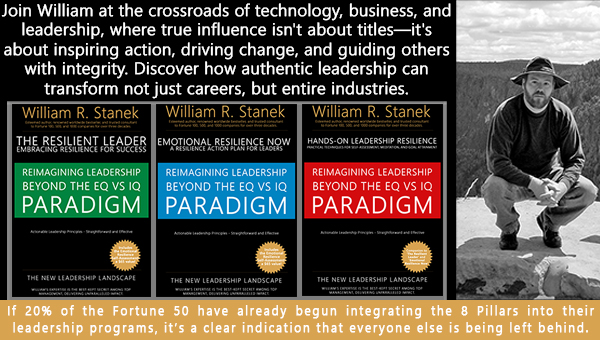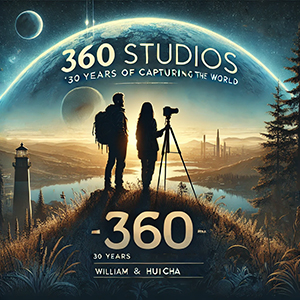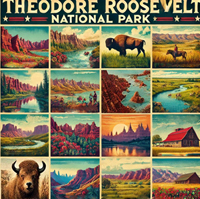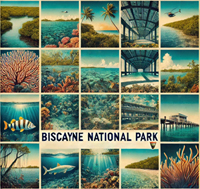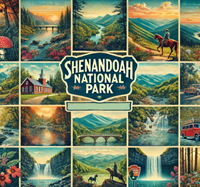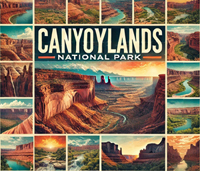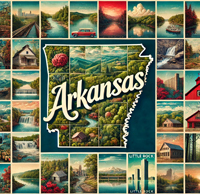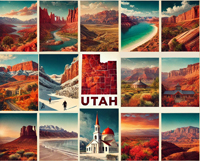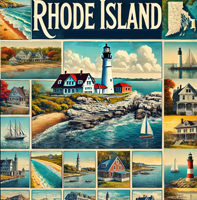
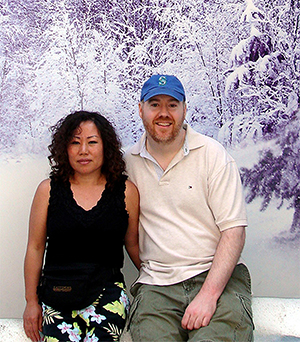
William and Hui Cha Stanek have meticulously crafted these national park guides, each showcasing the most stunning landscapes across the USA. But beyond the breathtaking scenery, these guides delve into the stories, experiences, and connections that make each park visit truly memorable.
National Parks Index | US Itineraries Index | American Roadtrips Index

Bring home a Bugville Critters book and watch as your child's love for reading and learning grows with every page. Hand-painted illustrations bring the heartwarming stories to life. Ask your librarian to add Bugville Critters to the library's digital collection today!
Discover William Stanek's Exclusive Art Collection
Explore and purchase the stunning art featured on this site. Own a piece of William Stanek's unique and captivating artwork today!
(May 17, 2025) Introducing Bryce Canyon National Park: Utah's Natural Amphitheater
Introduction to Bryce Canyon National Park
Bryce Canyon National Park is one of those places that looks like it was plucked straight out of a fantasy novel, with its towering hoodoos and surreal landscapes. I remember my first glimpse of the amphitheater from Sunrise Point-- rows upon rows of spire-like formations glowing in the early morning light. It was as if the earth had sculpted a grand cathedral out of sandstone. Hiking down into the canyon among these giant, otherworldly structures gave me a sense of walking through time itself. Bryce Canyon is a place where the forces of nature have created something truly magical, and every visit feels like discovering a new piece of its ancient secrets.
How to Reach Bryce Canyon National Park
From the North (Salt Lake City, UT): Travelers can take Interstate 15 south to UT-20 east, then follow US-89 south to UT-12 east to the park. The distance is approximately 270 miles, with a travel time of around 4.5 hours.
From the South (Las Vegas, NV): Visitors from Las Vegas can take Interstate 15 north to UT-9 east, then follow UT-89 north to UT-12 east to the park. This route covers about 270 miles and takes around 4.5 hours.
From the East (Denver, CO): From Denver, take Interstate 70 west to US-89 south, then follow UT-12 east to the park. This journey spans approximately 500 miles and takes around 8 hours.
From the West (Los Angeles, CA): Travelers from Los Angeles can take Interstate 15 north to UT-20 east, then follow US-89 south to UT-12 east to the park. This route covers approximately 500 miles and takes around 8 hours.
Exploring Bryce Canyon: Must-Visit Sites
- Bryce Amphitheater: The park's main attraction, featuring the highest concentration of hoodoos, accessible via several viewpoints and trails.
- Sunset Point: Offers stunning views of the Bryce Amphitheater and is a popular spot for photography.
- Navajo Loop Trail: A popular hiking trail that descends into the Bryce Amphitheater, passing through Wall Street and other unique formations.
- Rainbow Point: The highest point in the park, offering panoramic views of the surrounding area.
Seasonal Variations
Bryce Canyon's unique landscapes offer beauty year-round:
- Spring: Melting snow and blooming wildflowers create vibrant landscapes.
- Summer: Warm temperatures and clear skies provide ideal conditions for hiking and stargazing.
- Fall: Cooler temperatures and fewer visitors create a peaceful environment, with vibrant fall foliage in some areas.
- Winter: Snow-covered hoodoos offer a stark and beautiful contrast, ideal for solitude and photography.
Visitor Updates for Bryce Canyon National Park
Conservation Efforts
William Stanek's photography in Bryce Canyon emphasizes the park's unique geological formations and the importance of preserving its fragile ecosystems. His work supports efforts to protect the park from the impacts of erosion, climate change, and human activity.
1 Day at Bryce Canyon National Park: Utah's Hoodoo Haven
Introduction
Bryce Canyon National Park, located in southern Utah, is known for its unique hoodoos, colorful rock formations, and stunning amphitheaters. Here's a detailed guide to making the most of your visit, with expert tips from William and Hui Cha Stanek.
Morning: Sunrise and Scenic Views
6:00 AM - Sunrise at Sunrise Point
- Overview: Start your day with a breathtaking sunrise at Sunrise Point, offering stunning views of Bryce Amphitheater.
- Tips from William: Arrive early to set up your tripod and capture the sunrise. Use a wide-angle lens to encompass the entire scene.
- Insights from Hui Cha: Dress warmly and bring a thermos of hot coffee or tea. The early morning canyon air can be chilly.
7:30 AM - Breakfast at Bryce Canyon Lodge
- Overview: Head to Bryce Canyon Lodge for a quick breakfast with stunning views of the park.
- Tips from William: Capture the morning light on the surrounding rock formations and the lodge's architecture.
- Insights from Hui Cha: Enjoy a hearty breakfast to fuel your day. Grab some snacks and water for later.
Mid-Morning: Exploring the Hoodoos
8:30 AM - Navajo Loop Trail
- Overview: Hike the Navajo Loop Trail, which descends into the canyon and offers close-up views of the hoodoos.
- Tips from William: Use a wide-angle lens to capture the towering hoodoos and the narrow slot canyons. The morning light is perfect for photography.
- Insights from Hui Cha: The trail is moderately strenuous, so wear sturdy hiking shoes and bring plenty of water. The views are worth the effort.
10:30 AM - Queen's Garden Trail
- Overview: Continue your hike on the Queen's Garden Trail, which offers more stunning views of the unique rock formations.
- Tips from William: Use a telephoto lens to capture the details of the hoodoos and rock spires. The mid-morning light enhances the colors and textures.
- Insights from Hui Cha: The trail is relatively easy and offers great photo opportunities. Wear comfortable shoes and bring a hat.
Afternoon: Scenic Drives and Short Hikes
12:00 PM - Picnic Lunch at Bryce Point
- Overview: Enjoy a packed lunch at Bryce Point, with stunning panoramic views of Bryce Canyon.
- Tips from William: Capture candid moments of your picnic with the beautiful canyon backdrop.
- Insights from Hui Cha: Pack a nutritious and energizing meal. Take a moment to relax and enjoy the natural surroundings.
1:30 PM - Scenic Drive to Rainbow Point
- Overview: Drive along the scenic road to Rainbow Point, stopping at various overlooks along the way.
- Tips from William: Use a polarizing filter to reduce glare and enhance the colors of the landscape. Stop frequently to capture the stunning vistas.
- Insights from Hui Cha: Take your time and enjoy the drive. The road can be narrow and winding, so drive carefully.
3:00 PM - Bristlecone Loop Trail
- Overview: Hike the Bristlecone Loop Trail, a short trail that offers views of ancient bristlecone pines and the surrounding landscape.
- Tips from William: Use a wide-angle lens to capture the expansive views and the unique trees. Late afternoon light is ideal for photography.
- Insights from Hui Cha: The trail is easy and offers beautiful views. Wear comfortable shoes and bring water.
Late Afternoon: Photography and Relaxation
4:30 PM - Mossy Cave Trail
- Overview: Visit Mossy Cave Trail, which leads to a small cave and waterfall.
- Tips from William: Use a wide-angle lens to capture the cave and waterfall. Experiment with different compositions and perspectives.
- Insights from Hui Cha: This is a perfect spot to relax and take in the scenery. Bring a snack and enjoy the view.
Evening: Sunset and Dinner
6:00 PM - Sunset at Sunset Point
- Overview: Head to Sunset Point for a stunning sunset view over Bryce Canyon.
- Tips from William: Use a graduated neutral density filter to balance the exposure. Experiment with long exposures to capture the changing light.
- Insights from Hui Cha: Arrive early to find a good spot. Bring a light jacket as it can get cool after sunset.
7:30 PM - Dinner in Bryce Canyon City
- Overview: Return to Bryce Canyon City for a relaxing dinner at a local restaurant.
- Tips from William: Capture the evening atmosphere of the town. Try some local Utah cuisine to end your day.
- Insights from Hui Cha: Reflect on the day's adventures and enjoy a hearty meal. Bryce Canyon City offers a variety of dining options with a welcoming atmosphere.
Bryce Canyon National Park (Utah)
Bryce Canyon National Park, located in southern Utah, is renowned for its unique geological formations known as hoodoos, which are tall, thin spires of rock that protrude from the bottom of arid basins. Covering over 35,000 acres, the park offers breathtaking vistas, intricate rock formations, and clear, dark skies perfect for stargazing, making it a popular destination for photographers, hikers, and nature enthusiasts.Park History and Cultural Significance:
- Established as a national park in 1928, Bryce Canyon protects significant geological features and cultural resources.
- The area has a rich history of Native American habitation, particularly by the Paiute tribe. The park also preserves sites related to early European settlers and explorers.
Visitor Centers and Facilities:
- Bryce Canyon Visitor Center: Offers exhibits on the park's geology and history, a park film, maps, information, restrooms, and a gift shop.
- Campgrounds: The park has two campgrounds, North Campground and Sunset Campground, offering basic amenities like restrooms and picnic tables.
Best Times to Visit:
- Spring (April to June): Ideal for moderate temperatures and blooming wildflowers.
- Summer (July to September): Warm weather perfect for exploring the park, though it can be crowded.
- Fall (October to November): Cooler temperatures and fewer crowds make this a great time to visit, with beautiful fall foliage.
- Winter (December to March): Offers solitude and opportunities for winter activities like snowshoeing and cross-country skiing, but temperatures can be cold, and some roads and facilities may be closed.
Activities and Recreation:
- Hiking: Trails range from easy walks to challenging hikes, including the Navajo Loop Trail, Queen's Garden Trail, and the Fairyland Loop.
- Wildlife Watching: Opportunities to see mule deer, pronghorn, and a variety of bird species.
- Scenic Drives: The Bryce Canyon Scenic Drive offers breathtaking views of the park's landscapes and access to many trailheads and viewpoints.
- Camping: Campgrounds provide opportunities for both frontcountry and backcountry camping.
- Photography: The park's unique geological formations and stunning landscapes provide endless opportunities for photography, particularly at sunrise and sunset.
- Stargazing: The park's remote location offers excellent opportunities for stargazing and night photography.
Accessibility Information:
- The Bryce Canyon Visitor Center is wheelchair accessible.
- Accessible trails include the Rim Trail and the Bristlecone Loop.
- Accessible campgrounds and restrooms are available throughout the park.
Permits and Regulations:
- Entrance Fees: Required for entry; passes can be purchased online or at park entrances.
- Camping Permits: Required for camping at designated campgrounds. Reservations are recommended during peak seasons.
- Backcountry Permits: Required for overnight stays in backcountry areas.
- Special Use Permits: Needed for activities such as weddings, commercial filming, and large group gatherings.
Nearby: Grand Staircase-Escalante National Monument, Kodachrome Basin State Park, Zion National Park
-
Grand Staircase-Escalante National Monument: About an hour from Bryce Canyon, this monument features colorful cliffs, canyons, and plateaus. It's known for its geological formations and remote wilderness.
- Activities: Hiking, canyoneering, photography.
- Notable Sites: Calf Creek Falls, The Wave (requires a permit).
- Wildlife: Desert bighorn sheep, mountain lions, various reptiles.
-
Kodachrome Basin State Park: Located about 30 minutes from Bryce Canyon, this state park is named for its colorful rock formations that resemble a Kodak film. It offers unique spires and monolithic stone formations.
- Activities: Hiking, horseback riding, photography.
- Notable Trails: Angel's Palace Trail, Panorama Trail.
- Wildlife: Mule deer, foxes, numerous bird species.
-
Zion National Park: About an hour and a half from Bryce Canyon, Zion is known for its towering sandstone cliffs, narrow slot canyons, and diverse plant and animal life.
- Activities: Hiking, canyoneering, rock climbing.
- Notable Trails: Angels Landing, The Narrows.
- Wildlife: Mule deer, rock squirrels, peregrine falcons.
Important Updates for Bryce Canyon National Park
Bryce Canyon National Park (Utah)
Local Attractions and Surrounding Areas:
Bryce Canyon National Park, located in southern Utah, is known for its unique hoodoo rock formations, vibrant colors, and stunning vistas. The nearby town of Bryce Canyon City serves as the primary gateway to the park, providing a variety of amenities including lodging, dining, and shops. Bryce Canyon City is home to the Bryce Canyon Visitor Center, where visitors can obtain information, maps, and permits.
Further afield, the town of Tropic offers additional amenities and a more laid-back atmosphere. Tropic provides access to several trailheads and scenic viewpoints in the park. The nearby Kodachrome Basin State Park offers unique geological formations and opportunities for hiking and photography.
For those interested in exploring more of Utah's natural beauty, the nearby Grand Staircase-Escalante National Monument offers additional opportunities for hiking, canyoneering, and exploring unique geological formations.
Nearby Attractions:
-
Red Canyon: Located along Scenic Byway 12, Red Canyon features stunning red rock formations and several hiking trails. It's often referred to as a miniature version of Bryce Canyon.
-
Kodachrome Basin State Park: About 20 miles southeast of Bryce Canyon, this state park offers colorful rock formations, numerous hiking trails, and opportunities for horseback riding.
-
Dixie National Forest: Surrounding Bryce Canyon, this vast forest offers a range of outdoor activities, including hiking, fishing, and camping. Key points of interest include the scenic drive along Highway 12 and the Pine Valley Mountain Wilderness.
-
Grand Staircase-Escalante National Monument: A short drive from Bryce, this monument offers rugged terrain, slot canyons, and a wealth of geological and paleontological resources.
-
Cedar Breaks National Monument: Located about 60 miles west of Bryce, Cedar Breaks features a stunning natural amphitheater with vibrant red rock formations and lush alpine meadows.
Nearby Towns and Cities:
-
Bryce Canyon City: Located just outside the park entrance, this small town offers lodging, dining, and basic amenities. The Bryce Canyon Lodge, located within the park, provides historic accommodations and dining options.
-
Tropic: About 11 miles from Bryce Canyon, Tropic offers additional lodging and dining options. It's a good base for exploring both Bryce Canyon and nearby Kodachrome Basin State Park.
-
Panguitch: Approximately 24 miles from Bryce, Panguitch offers more extensive amenities, including hotels, restaurants, and shops. The town hosts the annual Panguitch Balloon Rally in June.
-
Escalante: Located about 48 miles east of Bryce, Escalante is a gateway to the Grand Staircase-Escalante National Monument. The town offers lodging, dining, and outfitters for outdoor adventures.
Scenic Drives
Bryce Canyon National Park features several scenic drives that showcase the park's dramatic landscapes and geological wonders.
-
Bryce Canyon Scenic Drive:
- Length: 18 miles one way
- Description: This scenic drive runs through the heart of Bryce Canyon, providing access to numerous viewpoints and trailheads. Key stops include Sunrise Point, Sunset Point, Inspiration Point, and Bryce Point. William recommends this drive for its accessibility and the variety of breathtaking viewpoints. The road continues to Rainbow and Yovimpa Points, offering views of the Grand Staircase.
-
Scenic Byway 12:
- Length: 122 miles one way
- Description: This All-American Road runs from Panguitch to Torrey, passing through Red Canyon, Bryce Canyon, and the Grand Staircase-Escalante National Monument. The drive offers stunning views of red rock canyons, high desert plateaus, and lush forests. Hui Cha suggests this drive for its diverse landscapes and the opportunity to explore multiple parks and monuments.
-
Cottonwood Canyon Road:
- Length: 47 miles one way
- Description: This scenic backcountry road runs through the Grand Staircase-Escalante National Monument, providing access to unique geological features and remote hiking trails. The road is unpaved and may require a high-clearance vehicle. William highlights this drive for its adventure and the chance to see lesser-known parts of the region.
Other Scenic Drives:
-
Kodachrome Basin Road: This scenic drive takes visitors through Kodachrome Basin State Park, offering stunning views of unique geological formations and vibrant colors. The road provides access to several hiking trails and viewpoints. Hui Cha highlights this drive for its beautiful scenery and the opportunity to explore some of the region's lesser-known areas.
Reservations and Timed Entry Information
Click the link to see updates. Wait up to 30 seconds for results.
Best Hikes
Bryce Canyon National Park offers a variety of hiking trails that showcase the park's unique hoodoos, vibrant colors, and stunning views. Here are some of the best hikes, with detailed insights from William and Hui Cha:
-
Navajo Loop Trail: This 1.3-mile loop is moderately difficult and takes hikers through the heart of Bryce Canyon's hoodoo formations. The trail features steep switchbacks, narrow canyons, and stunning views of the park's unique rock formations. Key points of interest along the trail include Wall Street and Thor's Hammer. William recommends this hike for its dramatic scenery and the opportunity to see the park's iconic hoodoos up close.
-
Queens Garden Trail: This 1.8-mile round trip hike is moderately easy and takes hikers from Sunrise Point to the Queen Victoria rock formation. The trail features beautiful views of hoodoos, rock formations, and the surrounding landscape. Hui Cha suggests this hike for its scenic beauty and the opportunity to see some of the park's most unique formations.
-
Peekaboo Loop Trail: This 5.5-mile loop is moderately difficult and takes hikers through some of Bryce Canyon's most stunning landscapes. The trail features steep climbs, narrow canyons, and breathtaking views of the park's hoodoos and rock formations. Key points of interest along the trail include the Wall of Windows and the Cathedral. The trail can be combined with the Navajo and Queen's Garden Trails for a longer hike. William highlights this hike for experienced hikers seeking a challenging and rewarding adventure.
-
Fairyland Loop Trail: This 8-mile loop is moderately difficult and offers stunning views of Bryce Canyon's hoodoos, rock formations, and vibrant colors. The trail features a mix of steep climbs and descents, providing a challenging and rewarding hike. Key points of interest along the trail include Tower Bridge and China Wall. Hui Cha recommends this hike for its panoramic vistas and the chance to explore some of the park's more remote areas. Note that this challenging trail offers a less crowded alternative to the more popular trails, passing through the northern part of the Bryce Amphitheater.
-
Bryce Point to Inspiration Point: This 3-mile round trip hike is moderately difficult and takes hikers along the rim of Bryce Canyon, offering stunning views of the park's hoodoos and rock formations. The trail features several viewpoints, including Bryce Point, Inspiration Point, and Sunset Point. William suggests this hike for its breathtaking views and the opportunity to see the park's vibrant colors from above.
-
Rim Trail: This 11-mile round trip hike is moderately easy and takes hikers along the rim of Bryce Canyon, offering panoramic views of the park's hoodoos and rock formations. The trail features several viewpoints and is accessible from multiple points along the rim. Hui Cha highlights this hike for its accessibility and the chance to see the park's stunning scenery from multiple perspectives.
-
Mossy Cave Trail: This 0.8-mile round trip hike is easy and takes visitors to a small waterfall and a mossy grotto. The trail features beautiful views of the surrounding landscape and provides a unique perspective on the park's geology. William recommends this hike for its short length and the opportunity to see a different side of Bryce Canyon. Note that the trail is located outside the main park area, near Tropic.
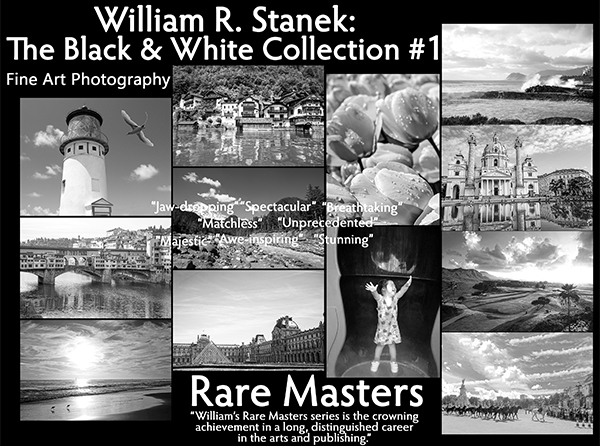
Step into a world of timeless beauty with our premium, oversized hardcover book - crafted for discerning collectors and anyone who values the power of art. Perfect for your coffee table, it's more than just a book; it's a conversation starter, a window into over 30 years of William's visionary photography.
Your Support Matters
Purchasing artwork from William Stanek's collection not only brings beauty into your life but also helps us continue to share. Thank you for supporting our creative journey!
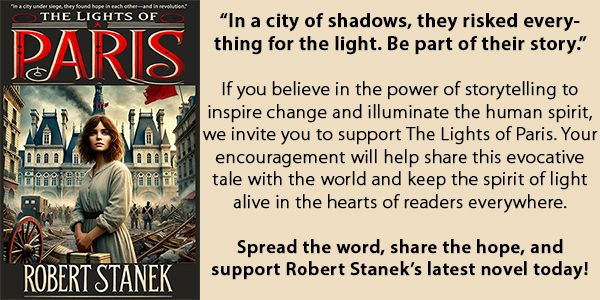
Support The Lights of Paris by Robert Stanek, William Stanek's pen name! Through vivid historical detail and deeply moving character stories, Robert takes readers on an unforgettable journey through one of history’s most transformative times.
